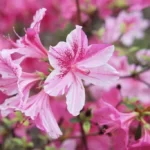Have you ever wondered if rhubarb plants can produce beautiful flowers? Rhubarb is a unique vegetable known for its tart stalks that are commonly used in pies and desserts. In this simple guide, we’ll explore the fascinating topic of rhubarb flowering and shed some light on whether these plants actually bloom. Let’s dive in and uncover the secrets of rhubarb’s flowering behavior.
- Victoria Rhubarb have large, dark red leaves and pink-red stems.
- Victoria Rhubarb Crown are easy to grow and can be planted in both spring and fall.
- Rhubarb plants can live for several years and will produce more stems each year. Victoria rhubarb can be used in a variety of culinary applications including pies, sauces, and jams.
- Victoria Rhubarb is a delicious choice known for its outstanding flavour that is easy to grow. Producing rosy stalks of firm but tartly sweet flesh that is topped with bushy green foliage; it is a popular choice for both novice and experienced gardeners.
Rhubarb Flowering
Rhubarb plants, scientifically known as Rheum rhabarbarum, are typically grown for their stalks rather than their flowers. These leafy vegetables have been cultivated for centuries for their culinary uses, but their flowering habits are not their main attraction. However, occasionally, you might spot a rhubarb plant with delicate flowers adorning its foliage.
Factors Affecting Rhubarb Flowering
The flowering behavior of rhubarb is influenced by several factors. One significant factor is the age of the plant. Young rhubarb plants tend to focus on establishing a strong root system and developing their foliage rather than producing flowers. On the other hand, older rhubarb plants, usually around three to five years old, are more likely to devote energy to flowering.
Stress and environmental conditions can also impact rhubarb flowering. A stressed rhubarb plant, due to inadequate watering, extreme temperatures, or poor soil conditions, may divert energy into producing flowers as a survival mechanism. Additionally, certain environmental triggers, such as extended periods of cold temperatures followed by a sudden warm spell, can induce rhubarb plants to flower.
While rhubarb flowering is not the plant’s primary purpose, it does occur under specific circumstances. However, it’s important to note that most cultivated rhubarb varieties have been specifically bred to minimize or eliminate flowering tendencies. This is because flowering can reduce the productivity and quality of the edible stalks that we love.
In the following sections, we’ll delve deeper into the occasional flowering of rhubarb and discuss its impact on the overall health and productivity of the plant. Let’s uncover more about this intriguing aspect of rhubarb’s life cycle!
Cultivated Rhubarb Varieties
When it comes to rhubarb, there are several cultivated varieties that have been specifically bred to prioritize stalk production over flowering. These varieties are selected for their robust growth and high-quality edible stalks. They are the stars of the rhubarb world, ensuring that we can enjoy delicious rhubarb pies and desserts.
These cultivated varieties have been carefully developed to minimize or eliminate the tendency to flower. This means that they put all their energy into producing those succulent and tangy stalks that we love. So, if you’re growing a common cultivated rhubarb variety, chances are you won’t see many flowers in your garden.
Occasional Flowering in Rhubarb
Despite the efforts to breed out flowering tendencies, some rhubarb plants may still surprise you with occasional blooms. This is more likely to occur in older plants that have reached their reproductive stage. As they age, some rhubarb plants may shift their focus from producing abundant stalks to producing flowers and seeds.
It’s also important to note that environmental factors and stress can influence the occasional flowering of rhubarb. If a rhubarb plant faces adverse conditions such as drought, extreme temperatures, or poor soil quality, it may respond by flowering as a survival mechanism. These flowers serve as a means for the plant to reproduce and ensure the survival of its genetic material.
While the occasional flowering in rhubarb can be visually appealing, it’s important to understand that it may come at the expense of the plant’s stalk production. Flowering requires energy and resources, which can divert the plant’s attention away from producing those juicy stalks we enjoy.
In the next sections, we’ll discuss the impact of flowering on the overall health of the rhubarb plant and address some common concerns and misconceptions related to rhubarb flowering. Let’s uncover more about the fascinating world of rhubarb and its occasional bursts of blooms!
Impact of Flowering on Rhubarb
While the occasional flowering of rhubarb plants can be visually appealing, it can have an impact on the overall health and productivity of the plant. When a rhubarb plant devotes its energy to flowering, it diverts resources away from producing robust stalks. As a result, you may notice a decrease in the quantity and quality of the edible stalks that you harvest for culinary purposes.
Flowering in rhubarb plants can also affect their longevity. Since flowering is part of the plant’s reproductive cycle, it signifies a transition toward the end of its life cycle. This means that a rhubarb plant that focuses on flowering may not continue to produce stalks for as many years as a plant that prioritizes stalk production.
Practical Considerations
For most gardeners, the primary objective of growing rhubarb is to enjoy the delicious and tangy stalks in various culinary creations. Therefore, it’s generally recommended to discourage flowering and prioritize stalk production. This can be achieved by selecting cultivated rhubarb varieties that have been bred to minimize flowering tendencies.
To promote optimal stalk growth and reduce the likelihood of flowering, ensure that your rhubarb plants receive proper care. Provide them with well-draining soil, ample sunlight, and adequate moisture. Regularly fertilize the plants with a balanced fertilizer to support healthy growth.
- Miracle-Gro Shake ‘N Feed Tomato, Fruit & Vegetable Plant Food feeds plants for up to 3 months, and nourishes above and below the soil
- This plant food contains calcium to help form stronger walls, producing better quality and longer-lasting fruits and vegetables
- For use with vegetable, fruit, and tomato plants, whether in-ground or indoor or outdoor container plants
- Apply this garden product evenly onto the soil and work into the top 1-3 inches of soil for in-ground plants, or lightly work into the soil of established container plants; water to start feeding
- Reapply Miracle-Gro Shake ‘N Feed Tomato, Fruit & Vegetable Plant Food every 3 months and water regularly for a beautiful garden all season long
Conclusion
In conclusion, while rhubarb plants can occasionally produce beautiful flowers, their main focus is on producing the tangy and edible stalks that we love. Cultivated rhubarb varieties have been specifically bred to minimize or eliminate flowering tendencies, ensuring that the plant’s energy is directed toward stalk production.
Understanding the impact of flowering on rhubarb plants allows us to make informed decisions when it comes to care and cultivation. By prioritizing stalk production and providing optimal growing conditions, we can enjoy bountiful harvests of rhubarb for many years to come. So, let’s celebrate the remarkable stalks of rhubarb and savor their delightful tartness in our favorite recipes!





